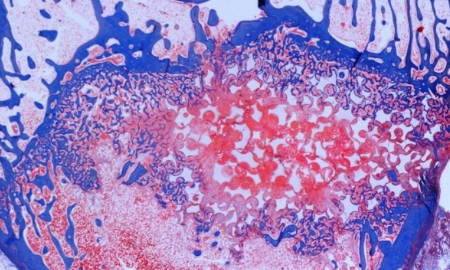In 1998, BIMA's director and principal investigator, Dr. Jeffrey Toth, and collaborator Dr. John Brekke formulated and published a definition for tissue engineering in the scientific literature: “Tissue engineering is an art and science by which synthetic compounds are manipulated into anatomically and/or functionally specific architectures and, when required, may be integrated with biologically active agents and/or living cells such that resultant properties of the whole are precisely suited to support the specific cell life prescribed for recipient tissues (Brekke and Toth).” Since that time, the OREC's Biomaterials and Histology Laboratory has been actively researching the use of bone graft substitutes and synthetic biomaterials as delivery vehicles for osteoinductive bone morphogenetic proteins. Bima has applied tissue engineering to back or spine musculoskeletal impairment, which has been reported to represent more than half of the musculoskeletal impairments in the United States. In the 18–84 age group, back or spine impairment is the leading cause of activity limitation and results in more lost productivity than any other medical condition. “For outstanding contributions in the field of Biomaterials and Tissue Engineering for research accomplishments and novel clinical applications to bone graft materials and carriers and spinal implant systems,” Dr. Toth was elected to the College of Fellows of the American Institute for Medical and Biological Engineering (AIMBE) in 2010. Located in Washington, D.C., AIMBE recognizes the top 2% of biomedical engineers in the country with the distinction of fellow.

Fig: Microradiograph of an undecalcified section through a cannulated and fenestrated titanium pedicle screw that delivered a bone morphogenetic protein to a sheep vertebral body
Selected Publications
Brekke JH and Toth JM: Principles of Tissue Engineering Applied to Programmable Osteogenesis. Journal of Biomedical Materials Research: Applied Biomaterials, 43(4):380-398, 1998.
Vögelin E, Jones NF, Ming-Huang JI, Brekke JH, and Toth JM: Practical Illustrations in Tissue Engineering: Surgical Considerations Relevant to the Implantation of Osteoinductive Devices. Tissue Engineering, 6(4):449-460, 2000.
Toth JM, Wang M, Patel CK, Arora A: Early Term Effects of rhBMP-2 on Pedicle Screw Fixation in a Sheep Model: Histomorphometric and Biomechanical Analyses. Journal of Spine Surgery, 4(3):534-545, 2018.
Toth JM, Foley KT, Wang M, Seim HB, and Turner AS: Is Lumbar Facet Fusion Biomechanically Equivalent to a Lumbar Posterolateral Onlay Fusion? Journal of Neurosurgery: SPINE, 26(5):586-593, May 2017.
Bae HW, Patel VV, Sardar ZM, Badura JM, Pradhan B, Seim HB, Turner AS, Toth JM: Transient Local Bone Remodeling Effects of rhBMP-2 in an Ovine Interbody Spine Fusion Model. Journal of Bone & Joint Surgery, 98-A(24):2061-2070, Dec 2016.
Toth JM, Wang M, Lawson J, Badura JM, Bailey DuBose K: Radiographic, Biomechanical, and Histologic Evaluation of rhBMP-2 in a Three-Level Intertransverse Process Spine Fusion: An Ovine Study. Journal of Neurosurgery: SPINE 25(6): 733-739, Dec 2016.
Toth JM, Schwartz DG, Mobasser J-P, Williams J: Instrumented Lumbar Corpectomy and Spinal Reconstruction Comparing rhBMP-2/Compression Resistant Matrix (CRM), rhBMP-2/Absorbable Collagen Sponge (ACS)/ Ceramic Granules Mixture, and Autograft In Two Different Devices—A Study In Sheep. 41(6): E313-E322, Mar 15, 2016.
Khan SN, Toth JM, Gupta K, Glassman SD, Gupta MC: Early and Mid-Term Histological Events During Single Level Posterolateral Intertransverse Process Fusion with rhBMP-2/Collagen Carrier and a Ceramic Bulking Agent in a Non-Human Primate Model: Implications For Bone Graft Preparation. Journal of Spinal Disorders & Techniques. 27(4): 212-219, 2014
VIEW MORE BIMA RESEARCH
Join BIMA
The Biomaterials & Histology Laboratory is looking for individuals with an interest in learning more about biomaterials or participating in collaborative research projects. For more information on becoming a member of BIMA, contact Dr. Toth.



